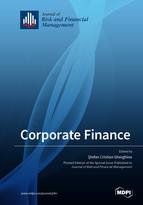Corporate Finance
A special issue of Journal of Risk and Financial Management (ISSN 1911-8074). This special issue belongs to the section "Economics and Finance".
Deadline for manuscript submissions: closed (31 August 2020) | Viewed by 104723
Special Issue Editor
Interests: corporate finance; corporate governance; quantitative finance; sustainable development
Special Issues, Collections and Topics in MDPI journals
Special Issue Information
Dear Colleagues,
Corporate finance is one of the most noteworthy topics in the financial sphere, being profoundly embedded in our everyday lives. Corporations require corporate finance to function and, more precisely, to create value. It is widely recognized that shareholder wealth maximization is the supreme objective of a company, and shareholders are the residual claimants. Nevertheless, when the suppliers of finance are different from those who control and exploit their assets, the need for corporate governance is crucial. Additionally, corporate social responsibility supports sustainable development by ensuring economic, social, and environmental benefits for all stakeholders. Further, going public leads to the creation of supplementary financing sources, greater visibility, and trustworthiness for the company, but with these opportunities come several downsides, such as openness to government and public scrutiny, strict disclosure requirements, or markets pressures. Therewith, mergers and acquisitions reveal a quick method for companies to advance the scale of their processes, widen their product portfolio, and pass in to novel markets. General topics of interest comprise but are not limited to:
- Investigating the specific determinants of capital structure;
- Analyzing the drivers of firm performance;
- Assessing bankruptcy risk;
- Inspecting the association between working capital and company performance;
- Exploring the relationship between corporate governance and firm value;
- Examining the causality between corporate social responsibility and dividend policy;
- Estimating the impact of mergers and acquisitions on stock prices.
Dr. Ştefan Cristian Gherghina
Guest Editor
Manuscript Submission Information
Manuscripts should be submitted online at www.mdpi.com by registering and logging in to this website. Once you are registered, click here to go to the submission form. Manuscripts can be submitted until the deadline. All submissions that pass pre-check are peer-reviewed. Accepted papers will be published continuously in the journal (as soon as accepted) and will be listed together on the special issue website. Research articles, review articles as well as short communications are invited. For planned papers, a title and short abstract (about 100 words) can be sent to the Editorial Office for announcement on this website.
Submitted manuscripts should not have been published previously, nor be under consideration for publication elsewhere (except conference proceedings papers). All manuscripts are thoroughly refereed through a single-blind peer-review process. A guide for authors and other relevant information for submission of manuscripts is available on the Instructions for Authors page. Journal of Risk and Financial Management is an international peer-reviewed open access monthly journal published by MDPI.
Please visit the Instructions for Authors page before submitting a manuscript. The Article Processing Charge (APC) for publication in this open access journal is 1400 CHF (Swiss Francs). Submitted papers should be well formatted and use good English. Authors may use MDPI's English editing service prior to publication or during author revisions.
Keywords
- Company performance
- Business valuation
- Capital structure decisions
- Business failure risk
- Working capital management
- Corporate liquidity management
- Dividend policy
- Corporate governance
- Corporate social responsibility
- Mergers and acquisitions





